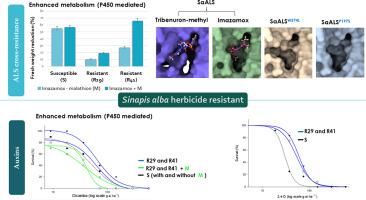当前位置:
X-MOL 学术
›
Pestic. Biochem. Phys.
›
论文详情
Our official English website, www.x-mol.net, welcomes your feedback! (Note: you will need to create a separate account there.)
Pro197Ser and the new Trp574Leu mutations together with enhanced metabolism contribute to cross-resistance to ALS inhibiting herbicides in Sinapis alba
Pesticide Biochemistry and Physiology ( IF 4.7 ) Pub Date : 2024-03-19 , DOI: 10.1016/j.pestbp.2024.105882 Myriem Chtourou , Maria D. Osuna , José G. Vázquez-García , Jorge Lozano-Juste , Rafael De Prado , Joel Torra , Thouraya Souissi
Pesticide Biochemistry and Physiology ( IF 4.7 ) Pub Date : 2024-03-19 , DOI: 10.1016/j.pestbp.2024.105882 Myriem Chtourou , Maria D. Osuna , José G. Vázquez-García , Jorge Lozano-Juste , Rafael De Prado , Joel Torra , Thouraya Souissi

|
White mustard, (), a problematic broadleaf weed in many Mediterranean countries in arable fields has been detected as resistant to tribenuron-methyl in Tunisia. Greenhouse and laboratory studies were conducted to characterize Target-Site Resistance (TSR) and the Non-Target Site Resistance (NTSR) mechanisms in two suspected white mustard biotypes. Herbicide dose-response experiments confirmed that the two biotypes were resistant to four dissimilar acetolactate synthase (ALS)-pinhibiting herbicide chemistries indicating the presence of cross-resistance mechanisms. The highest resistance factor (>144) was attributed to tribenuron-methyl herbicide and both R populations survived up to 64-fold the recommended field dose (18.7 g ai ha). In this study, the metabolism experiments with malathion (a cytochrome P450 inhibitor) showed that malathion reduced resistance to tribenuron-methyl and imazamox in both populations, indicating that P450 may be involved in the resistance. Sequence analysis of the gene detected target site mutations in the two R biotypes, with amino acid substitutions Trp574Leu, the first report for the species, and Pro197Ser. Molecular docking analysis showed that ALS enzyme cannot properly bind to tribenuron-methyl's aromatic ring due to a reduction in the number of hydrogen bonds, while imazamox can still bind. However, Trp574Leu can weaken the binding affinity between the mutated ALS enzyme and both herbicides with the loss of crucial interactions. This investigation provides substantial evidence for the risk of evolving multiple resistance in to auxin herbicides while deciphering the TSR and NTSR mechanisms conferring cross resistance to ALS inhibitors.
中文翻译:

Pro197Ser 和新的 Trp574Leu 突变以及代谢增强导致白芥对 ALS 抑制除草剂的交叉抗性
白芥菜()是许多地中海国家耕地中的一种有问题的阔叶杂草,在突尼斯已被检测出对苯磺隆具有抗药性。进行了温室和实验室研究,以表征两种可疑白芥菜生物型的靶点抗性(TSR)和非靶点抗性(NTSR)机制。除草剂剂量反应实验证实,这两种生物型对四种不同的乙酰乳酸合酶(ALS)抑制性除草剂化学物质具有抗性,表明存在交叉抗性机制。最高的抗性因子(>144)归因于苯磺隆除草剂,两个 R 群体的存活率高达推荐田间剂量(18.7 g ai ha)的 64 倍。在这项研究中,马拉硫磷(一种细胞色素P450抑制剂)的代谢实验表明,马拉硫磷降低了两个人群对苯磺隆和甲咪草烟的耐药性,表明P450可能参与了耐药性。该基因的序列分析检测到两种 R 生物型中的靶位点突变,其中氨基酸替换为 Trp574Leu(该物种的首次报告)和 Pro197Ser。分子对接分析表明,由于氢键数量减少,ALS酶无法与苯磺隆的芳香环正确结合,而甲咪草烟仍能结合。然而,Trp574Leu 会削弱突变的 ALS 酶与两种除草剂之间的结合亲和力,从而丧失关键的相互作用。这项研究为证明对生长素除草剂产生多重耐药性的风险提供了充分的证据,同时破译了 TSR 和 NTSR 机制赋予对 ALS 抑制剂的交叉耐药性。
更新日期:2024-03-19
中文翻译:

Pro197Ser 和新的 Trp574Leu 突变以及代谢增强导致白芥对 ALS 抑制除草剂的交叉抗性
白芥菜()是许多地中海国家耕地中的一种有问题的阔叶杂草,在突尼斯已被检测出对苯磺隆具有抗药性。进行了温室和实验室研究,以表征两种可疑白芥菜生物型的靶点抗性(TSR)和非靶点抗性(NTSR)机制。除草剂剂量反应实验证实,这两种生物型对四种不同的乙酰乳酸合酶(ALS)抑制性除草剂化学物质具有抗性,表明存在交叉抗性机制。最高的抗性因子(>144)归因于苯磺隆除草剂,两个 R 群体的存活率高达推荐田间剂量(18.7 g ai ha)的 64 倍。在这项研究中,马拉硫磷(一种细胞色素P450抑制剂)的代谢实验表明,马拉硫磷降低了两个人群对苯磺隆和甲咪草烟的耐药性,表明P450可能参与了耐药性。该基因的序列分析检测到两种 R 生物型中的靶位点突变,其中氨基酸替换为 Trp574Leu(该物种的首次报告)和 Pro197Ser。分子对接分析表明,由于氢键数量减少,ALS酶无法与苯磺隆的芳香环正确结合,而甲咪草烟仍能结合。然而,Trp574Leu 会削弱突变的 ALS 酶与两种除草剂之间的结合亲和力,从而丧失关键的相互作用。这项研究为证明对生长素除草剂产生多重耐药性的风险提供了充分的证据,同时破译了 TSR 和 NTSR 机制赋予对 ALS 抑制剂的交叉耐药性。



























 京公网安备 11010802027423号
京公网安备 11010802027423号